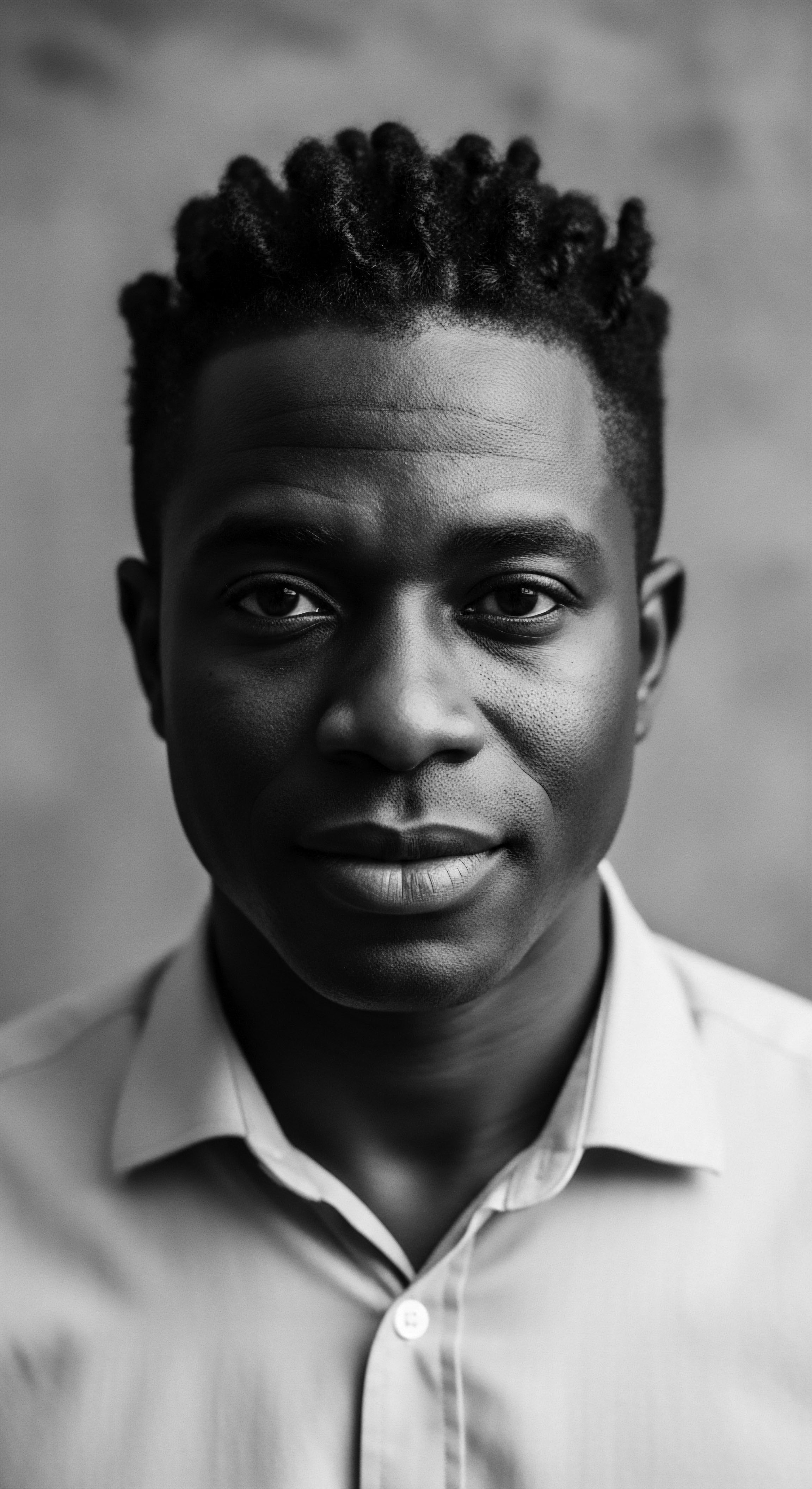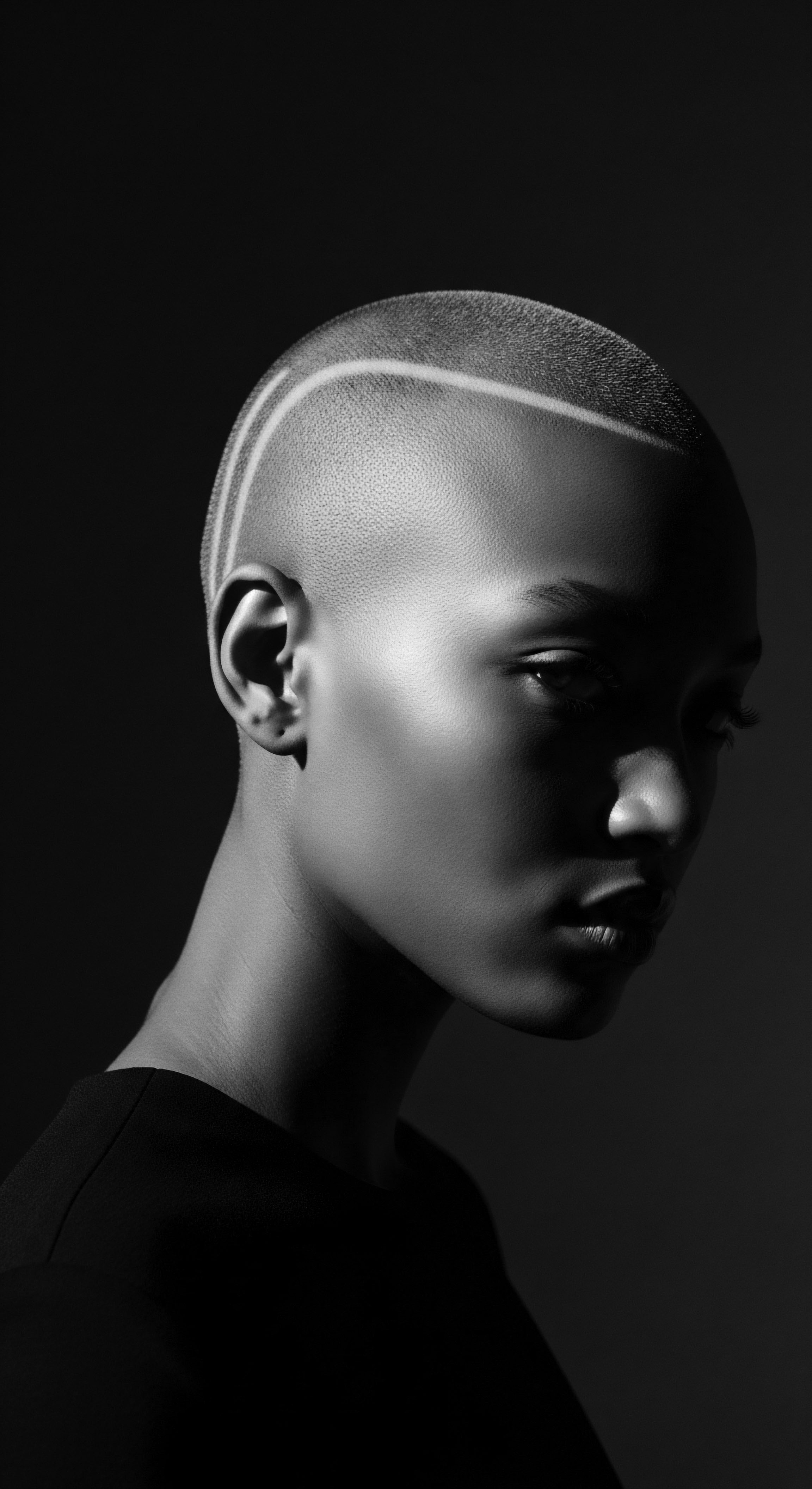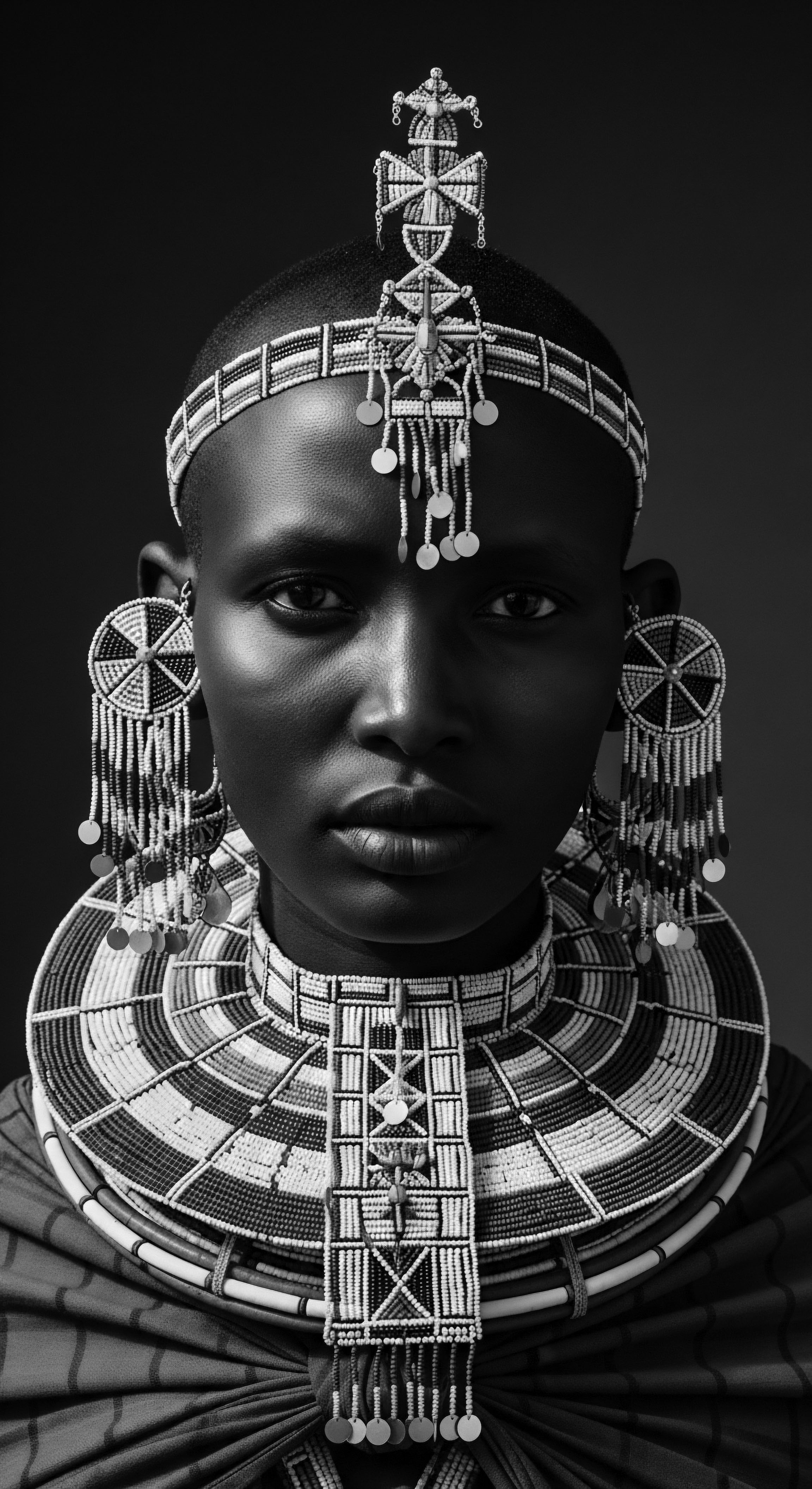
Roots
Consider the stories etched into each curl, every coil, a testament to journeys that span continents and centuries. Our hair, more than simple protein strands, is a living archive, holding the whispers of those who came before us, their triumphs and their sustenance. It begs a question, then ❉ can what we consume, the very earth’s bounty taken into our bodies, truly reshape this deep, ancestral marker? The relationship between our internal landscape, our diet, and the external expression of our textured hair unfolds as a narrative of profound connection, stretching back to the earliest ancestral practices.
The fibers that crown us, known in scientific terms as the hair shaft, grow from within the scalp, nourished by a intricate web of blood vessels. These vessels deliver the fundamental building blocks—proteins, vitamins, minerals—that determine the strength, elasticity, and even the appearance of our hair. For textured hair, with its unique helical structure and often drier nature, these internal provisions carry even greater weight. A strand of coiled hair possesses more points of vulnerability along its twists and turns, making consistent, nutrient-rich internal support an absolute necessity.
The lineage of our hair reveals itself not only in its visible form but also in the invisible sustenance drawn from the earth and traditions.

Hair Anatomy and Physiology from an Ancestral Lens
Across various African civilizations, hair was not merely an aesthetic feature. It was a language, a symbol of identity, status, and spiritual connection. The perceived health and vitality of hair were directly linked to a person’s overall well-being, suggesting an intuitive understanding of the body’s internal state influencing its external appearance. Ancient communities inherently understood that robust hair signaled a robust existence, an implicit acknowledgment of deep nourishment from the inside.
This traditional knowledge, often passed down through generations, did not always articulate the precise mechanisms of cellular metabolism or protein synthesis in the way modern science does. Yet, the practices themselves, focusing on whole, unprocessed foods, fermented grains, and a bounty of diverse plant life, provided the very nutrients now validated by contemporary research as crucial for hair vitality. The knowledge was experiential, observed over countless lifetimes and refined through communal wisdom.

Traditional Classifications of Textured Hair and Underlying Realities
Modern systems attempt to categorize textured hair using numbers and letters, often struggling to encompass the infinite variations that exist within the African diaspora. These classifications, while aiming for clarity, sometimes miss the fluidity and individual differences that define this hair type. Ancestral communities, however, frequently understood hair through qualities that reflected its health and response to traditional care—its resilience, its sheen, its ability to hold a style.
The notion that a certain hair type was “hard to manage” or “dry” often stemmed from a lack of understanding or access to traditional care methods, or perhaps, a diet that lacked the very elements needed to support its unique structure. The very texture of our coils, those tight, springy formations, relies on a balanced interplay of disulfide bonds within the keratin protein. Any disruption to this foundational protein synthesis, often rooted in insufficient dietary intake, can alter hair’s integrity, leading to brittleness or a perceived change in curl pattern.
Consider the history of forced migration, a period marked by devastating shifts in every aspect of life for enslaved Africans. Torn from their ancestral lands, they faced severe deprivation, including drastic alterations to their diets. The nutrient-rich traditional foods—diverse grains, leafy vegetables, legumes, and fish—were largely replaced by meager rations of unfamiliar, often processed, and nutritionally inadequate provisions. This profound dietary disruption led to widespread malnourishment, a condition that medical observations of the era could discern in symptoms like skin changes and hair alterations, though the underlying mechanisms were yet to be fully articulated (Eichholz, 1965).
The very vitality of the hair, which had been celebrated in pre-colonial societies for its thickness and health, would have been compromised, manifesting as brittleness, thinning, and a loss of natural sheen. This historical reality offers a somber, compelling example of how drastic dietary changes can indeed alter the visible qualities of textured hair, not through a shift in genetic curl pattern, but through a fundamental erosion of its health.

Essential Language of Textured Hair from a Heritage View
The way we speak about textured hair has evolved, yet many contemporary discussions could benefit from reconnecting with the language that has historically described its qualities, care, and cultural meaning. Words like “coil,” “kink,” “wave,” and “curl” are now common, but the richer lexicon of heritage brings forward terms that speak to traditional preparations, the feel of hair after ancestral treatments, or the communal bonds forged through its care.
- Shea Butter ❉ A revered emollient from the karite tree, traditionally used across West Africa not simply as a topical sealant but often integrated into broader wellness practices that included internal consumption of healthful fats.
- Chebe Powder ❉ A blend of specific herbs, originating from the Basara Arab women of Chad, employed in rituals where its application for length retention hints at a deep understanding of protein fortification, even if the precise science was unknown.
- Ghee ❉ Clarified butter, used for centuries in East African communities, particularly in the Horn of Africa, not only as a culinary staple but also directly applied to hair as a conditioning agent, showcasing an intuitive link between nourishing fats and hair vitality (Emilytibexo, 2025).

Hair Growth Cycles and Historical Influences
Hair growth follows a cycle of distinct phases ❉ anagen (growth), catagen (transition), and telogen (rest). The length of the anagen phase largely determines how long our hair can grow. While genetics play a significant role in determining the typical duration of these cycles, environmental factors, including nutrition, have always exerted influence. In ancestral communities, where food scarcity could be a real threat, periods of insufficient nourishment would inevitably shorten the active growth phase, leading to less hair density or slower growth.
Our forebears, acutely attuned to the rhythms of nature and the availability of sustenance, would have observed these shifts. The resilience of hair, its ability to recover after periods of hardship, was tied to the body’s capacity to replenish its stores. This knowledge informed not only their choice of foods but also their care practices, many of which focused on creating an optimal scalp environment to support growth, often implicitly bolstering the internal supply lines.
For generations, the very diet of African communities reflected a profound ecological wisdom. They consumed what the land provided, a diverse array of whole grains, tubers, leafy vegetables, and sources of protein from both land and water. This dietary baseline, rich in antioxidants, vitamins, and minerals, naturally supported healthy physiological functions, including the integrity of hair. When these connections were severed through historical dislocations, the physical manifestation of hair often bore witness to the disruption.

Ritual
The practice of hair care, for Black and mixed-race communities, has always been more than a simple act of grooming. It carries the weight of history, the warmth of communal bonds, and the quiet power of self-expression. Within these rituals, the unseen influence of diet, the very essence of what we take into our bodies, has played a role, sometimes subtle, sometimes profound. The transformation of textured hair, whether through protective styles or daily definition, is intrinsically linked to its internal resilience, a resilience nourished by the dietary choices that stretch back through time.
Each twist, each braid, each careful application of ancestral oils and butters carries the memory of practices designed to fortify hair that was understood to be both delicate and strong. These techniques were not developed in a vacuum; they arose from a deep understanding of the hair’s inherent nature, an understanding often shaped by generations of observation of how the body, when properly sustained, yielded vibrant hair.

Protective Styling from Ancestral Roots
Protective styles, such as cornrows, braids, and twists, hold a venerable place in the heritage of textured hair care. These methods, designed to shield delicate ends and minimize manipulation, allowed hair to retain length and health. What is less often spoken of is how the very hair being protected was inherently stronger or weaker based on the internal environment created by diet. A history of robust, nutrient-dense diets in many African societies meant that hair, even before styling, possessed a certain vitality.
When communities transitioned to less healthful diets, as happened during periods of enslavement and subsequent socio-economic hardships, the hair itself became more fragile. This increased fragility likely amplified the need for protective styles, turning them from adornments and cultural markers into necessary strategies for survival. The styles adapted, reflecting a practical response to changed circumstances, where hair needed even more external support to compensate for diminished internal nourishment.
Hair care rituals, inherited through generations, reveal the profound link between external practices and the internal landscape shaped by sustenance.

Natural Styling Techniques and Ancient Ways
Defining natural curls, coils, and waves has always been an art. From finger coiling to various setting methods, these techniques enhance the innate beauty of textured hair. The efficacy of these methods, however, depends heavily on the hair’s inherent qualities ❉ its spring, its elasticity, its capacity to absorb and retain moisture. These qualities are, at their elemental core, a reflection of the building blocks provided by one’s diet.
Consider the prevalence of hair steaming in some traditional African practices, using warm water or herbal infusions. This warmth helps the hair shaft absorb moisture. But for this moisture to truly benefit the strand, the hair itself needs to be structurally sound, with intact cuticles and a strong protein matrix—qualities directly influenced by adequate protein, healthy fats, and micronutrients. The application of oils derived from dietary staples, such as palm oil or shea butter, served a dual purpose ❉ providing external conditioning while reflecting an implicit understanding of the nourishing properties of these very foods.
| Nutrient Group Proteins |
| Ancestral Dietary Sources Legumes, fish, lean game, traditional grains (millet, sorghum) |
| Impact on Hair Qualities Strength, elasticity, curl definition. Essential for keratin formation. |
| Nutrient Group Omega-3 Fatty Acids |
| Ancestral Dietary Sources Fatty fish (mackerel, sardines), flaxseeds, certain wild seeds |
| Impact on Hair Qualities Scalp health, natural sheen, moisture retention. Supports cellular membranes. |
| Nutrient Group Vitamins A, C, E |
| Ancestral Dietary Sources Leafy greens, sweet potatoes, fruits (mango, papaya), nuts |
| Impact on Hair Qualities Sebum production, collagen synthesis, antioxidant protection. Supports follicle health. |
| Nutrient Group Iron & Zinc |
| Ancestral Dietary Sources Spinach, lentils, beans, red meat, fortified grains |
| Impact on Hair Qualities Oxygen delivery to follicles, cell division, hormone regulation. Critical for growth cycles. |
| Nutrient Group The consistency and abundance of these nutrients, particularly in traditional diets, provided a strong foundation for vibrant, healthy textured hair. |

Wigs and Extensions from a Historical Standpoint
While often viewed through a contemporary lens of fashion or convenience, the use of wigs and hair extensions also has a rich historical and cultural tradition in African societies, extending far beyond their modern permutations. In ancient Egypt, for instance, wigs were status symbols, meticulously crafted and often adorned. In other African cultures, false hair or added extensions were used to create elaborate, ceremonial styles that conveyed social standing, age, or marital status.
This heritage of augmentation speaks to a long-standing appreciation for volume, length, and artistic expression in hair. While the modern usage of wigs and extensions can sometimes be a response to hair damage from harsh styling or inadequate nutrition, their historical roots suggest a continuity of valuing diverse hair aesthetics, irrespective of hair’s natural state. The desire for certain appearances, then as now, sometimes transcended the direct physiological state of one’s hair, yet underlying hair health remained a consideration for comfort and longevity of wear.

Tools of Care and the Legacy of Nourishment
The complete textured hair toolkit, from wide-tooth combs to bonnets, has its own lineage. Many traditional tools, crafted from natural materials, were designed to gently work with the hair’s coiled nature, minimizing breakage. The historical application of rich, natural ingredients—oils, clays, plant extracts—was often accompanied by massages and slow, deliberate movements, promoting circulation to the scalp.
This holistic approach implicitly understood that stimulating the scalp was part of fostering growth, a process that is, at its base, reliant on the internal supply of nutrients. A scalp well-fed from within and cared for with gentle external touch would be better equipped to support vibrant strands. The legacy of these tools and techniques speaks to a deep, practical wisdom in safeguarding hair, a wisdom that complemented, and was often made possible by, a nourishing diet.

Relay
The journey of understanding textured hair care extends beyond the visible strands and styling rituals; it delves into the intricate relay of signals between our diet, our internal systems, and the very composition of our hair. This is where ancestral wisdom meets contemporary science, forming a bridge between the deep knowledge passed down through generations and the precise insights offered by modern research. The question of whether dietary adjustments can truly alter textured hair finds its most compelling answers here, in the interwoven narratives of biological response and cultural adaptation.
Every meal we consume provides the raw materials for cellular function throughout our body, including the hair follicles. These tiny organs, nestled beneath the scalp, are factories for hair protein, and their efficiency is directly proportional to the quality of the nutrients they receive. When the internal environment is replete with essential vitamins, minerals, and amino acids, the hair produced tends to be stronger, more flexible, and better equipped to withstand environmental stresses and styling manipulations.

Personalized Regimens and Ancestral Wisdom
Building a hair regimen, whether for textured hair or any type, requires a personalized approach. Yet, this personalization can draw strength from ancestral blueprints. Traditional African hair care practices often emphasized ingredients readily available from the local environment, used in rhythms that aligned with natural cycles. These were not random choices; they reflected centuries of empirical observation about what worked to support hair health within specific ecological contexts.
Modern science now validates many of these traditional ingredients. For instance, the fatty acids in shea butter or the antioxidants in certain plant extracts (like Rooibos tea, traditionally cultivated in South Africa) are now understood for their protective and nourishing properties (DatelineHealth Africa, 2025; Sellox Blog, 2021). The careful selection of foods for internal nourishment aligns with the external application of complementary botanicals, forming a cohesive system of care.
Consider the significant relationship between our food systems and hair health, a relationship particularly apparent when observing historical disruptions. The transatlantic slave trade, a period of profound human suffering, severed countless individuals from their traditional dietary patterns. On the slave ships and plantations, the limited, often monotonous, and nutritionally deficient rations—typically consisting of low-quality grains, meager protein, and few fresh fruits or vegetables—would have induced widespread nutritional deficiencies.
This forced dietary shift, a stark departure from the varied, nutrient-dense ancestral African diets, would have resulted in tangible changes in hair health ❉ increased brittleness, slower growth, and a loss of the vibrant resilience seen in prior generations. The hair, in its weakened state, mirrored the systemic impact of forced malnutrition, serving as a silent, physical record of historical trauma and survival.

The Nighttime Sanctuary and Bonnet Wisdom
The wisdom of protecting textured hair during sleep is a practice passed down through generations, long before modern silk pillowcases became a common household item. Head wraps and bonnets, fashioned from smooth, natural materials, were used to guard against friction and moisture loss overnight. This simple ritual, often overlooked in mainstream beauty narratives, holds profound significance for hair retention and strength.
The body’s repair and regenerative processes often occur most efficiently during rest. Ensuring that hair is protected during this period means it retains the moisture and nutrients absorbed during the day, whether from topical products or, more fundamentally, from the body’s internal supply. Adequate sleep, supported by a nourishing diet, also contributes to overall hormonal balance, which can indirectly influence hair growth and health. The nighttime routine, then, becomes a powerful intersection of external care and internal well-being.

Ingredient Deep Dives and Traditional Knowledge
When we examine the common elements that comprise textured hair, proteins like keratin stand paramount. Our bodies synthesize this protein from amino acids obtained through our diet. A lack of sufficient protein, or an imbalance of certain amino acids, can directly impact the hair’s structure, leading to weakness and breakage (Rupa Health, 2024).
| Nutrient Iron |
| Why It Matters for Textured Hair Oxygen transport to follicles; deficiency can lead to shedding. Textured hair can be prone to breakage, making robust growth critical. |
| Traditional/Modern Sources Leafy greens (spinach, kale), lentils, red meat, beans. |
| Nutrient Zinc |
| Why It Matters for Textured Hair Cell division in follicles; balances oil glands. Supports hair growth cycles. |
| Traditional/Modern Sources Oysters, nuts, beans, fortified grains. |
| Nutrient Biotin (B7) |
| Why It Matters for Textured Hair Keratin production. Vital for hair's primary structural component. |
| Traditional/Modern Sources Eggs, sweet potatoes, almonds, whole grains. |
| Nutrient Vitamin D |
| Why It Matters for Textured Hair Follicle development and growth cycle regulation. Deficiency linked to hair loss. |
| Traditional/Modern Sources Sunlight exposure, fatty fish, fortified foods. |
| Nutrient Omega-3 Fatty Acids |
| Why It Matters for Textured Hair Reduces scalp inflammation, supports natural oils. Crucial for moisture retention in textured hair. |
| Traditional/Modern Sources Fatty fish (salmon, mackerel), chia seeds, flaxseeds. |
| Nutrient A deficiency in any of these, historically exacerbated by periods of dietary upheaval, can affect the resilience and appearance of textured hair. |
Micronutrients, though needed in smaller quantities, play equally important roles. Iron supports oxygen delivery to hair follicles, crucial for cellular growth. Zinc is involved in protein synthesis and cell division within the hair follicle. Biotin, a B vitamin, is directly linked to keratin production (Kaya Skin Clinic, 2024).
These are not simply modern discoveries; many traditional African diets were inherently rich in these elements. The transition from agrarian, diverse diets to more industrialized, nutrient-poor foods often correlated with observed declines in hair vitality within communities.
The wisdom of our ancestors, reflected in dietary choices and care practices, often predates scientific articulation of hair’s cellular needs.

Holistic Influences on Hair Health and Ancestral Philosophies
Ancestral wellness philosophies rarely isolated one part of the body from the whole. Hair health was understood as an outward manifestation of internal equilibrium. Stress, illness, and emotional well-being were all considered integral to a person’s overall vitality, including their hair. This holistic perspective provides a powerful framework for understanding how diet, alongside other lifestyle factors, can profoundly influence textured hair.
When we consider how a diet rich in highly processed foods and sugars can contribute to systemic inflammation, we begin to connect modern dietary patterns to issues like dry scalp, slower growth, or increased shedding—conditions that our ancestors might have remedied with specific herbs or dietary changes that, in hindsight, addressed inflammation or nutrient deficiencies. The connection between gut health and overall systemic well-being, including the health of skin and hair, is a growing area of scientific interest, effectively echoing the ancient understanding that “you are what you eat.”

Reflection
As we step back from the intricate mechanisms and historical currents that bind diet to the very structure of textured hair, a profound truth emerges ❉ our strands are more than just biology; they are living testaments to lineage, resilience, and wisdom. The question of whether diet changes can truly alter textured hair finds its answer not merely in scientific papers, but in the enduring heritage woven into each coil and kink. From the vibrant, nutrient-rich diets of ancestral African communities to the challenging shifts imposed by forced migration, our hair has silently borne witness to the stories of our sustenance.
The ‘Soul of a Strand’ ethos, then, becomes a guiding light. It reminds us that caring for textured hair reaches beyond superficial treatments. It requires a reverence for the past, an understanding of the nutritional foundations that supported our forebears, and a conscious choice to honor those legacies in our present-day lives. Our journey with our hair becomes a dialogue across generations, a conversation between the body’s elemental needs and the deeply ingrained practices of our collective heritage.
To acknowledge the power of diet in shaping textured hair is to reclaim a piece of ancestral knowledge, recognizing that nourishment from within has always been, and remains, a cornerstone of its vitality. This understanding empowers us to see our hair not as a challenge, but as a dynamic reflection of our health, our history, and our inherent connection to the earth’s bounty. It is a continuous narrative, an unbound helix, ever growing, ever evolving, yet forever rooted in the wisdom of those who came before.

References
- DatelineHealth Africa. (2025). Top 10 African Foods for Healthy Hair.
- Eichholz, F. (1965). Malnutrition in the history of tropical Africa. Zeitschrift für Tropenmedizin und Parasitologie, 16(1), 1–18.
- Emilytibexo. (2025). African Ancestors Hair Routine. TikTok.
- Kaya Skin Clinic. (2024). Vitamin Deficiencies Causing Hair Loss ❉ Understand and Prevent.
- Rupa Health. (2024). Nutrient Deficiencies Responsible for Hair Loss.
- Sellox Blog. (2021). Ancient African Hair Growth Secrets For Healthy Hair.
